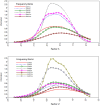The significant others' responses to trauma scale (SORTS): applying factor analysis and item response theory to a measure of PTSD symptom accommodation
- PMID: 38836407
- PMCID: PMC11155430
- DOI: 10.1080/20008066.2024.2353530
The significant others' responses to trauma scale (SORTS): applying factor analysis and item response theory to a measure of PTSD symptom accommodation
Abstract
Background: Symptom accommodation by family members (FMs) of individuals with posttraumatic stress disorder (PTSD) includes FMs' participation in patients' avoidance/safety behaviours and constraining self-expression to minimise conflict, potentially maintaining patients' symptoms. The Significant Others' Responses to Trauma Scale (SORTS) is the only existing measure of accommodation in PTSD but has not been rigorously psychometrically tested.Objective: We aimed to conduct further psychometric analyses to determine the factor structure and overall performance of the SORTS. Method: We conducted exploratory and confirmatory factor analyses using a sample of N = 715 FMs (85.7% female, 62.1% White, 86.7% romantic partners of individuals with elevated PTSD symptoms).Results: After dropping cross-loading items, results indicated good fit for a higher-order model of accommodation with two factors: an anger-related accommodation factor encompassed items related largely to minimising conflict, and an anxiety-related accommodation factor encompassed items related primarily to changes to the FM's activities. Accommodation was positively related to PTSD severity and negatively related to relationship satisfaction, although the factors showed somewhat distinct associations. Item Response Theory analyses indicated that the scale provided good information and robust coverage of different accommodation levels.Conclusions: SORTS data should be analysed as both a single score as well as two factors to explore the factors' potential differential performance across treatment and relationship outcomes.
Antecedentes: La acomodación de los síntomas por miembros de la familia (MFs) de las personas con trastorno de estrés postraumático (TEPT) incluye a la participación de los MFs en las conductas de evitación/seguridad y la contención de las propias expresiones para minimizar el conflicto, lo que potencialmente promueve la continuidad de los síntomas del paciente. La escala para la respuesta de las personas significativas (SORTS por sus siglas en inglés) es la única escala desarrollada para medir la acomodación de los síntomas en el TEPT, pero no ha sido evaluada psicométricamente de forma rigurosa.
Objetivo: Conducir análisis psicométricos adicionales para determinar la estructura factorial y el desempeño general de la SORTS.
Métodos: Se realizó un análisis factorial exploratorio y confirmatorio a partir de una muestra de n = 715 MFs (85,7 % mujeres, 62,1 % de raza blanca, 86,7 % parejas románticas de personas con elevados síntomas del TEPT).
Resultados: Luego de retirar ítems con cargas cruzadas, los resultados indicaron un adecuado ajuste para un modelo de acomodación de orden alto con dos factores: un factor de acomodación asociado con la ira que incluía ítems ampliamente relacionados a la minimización de conflicto y un factor de acomodación asociado a la ansiedad que incluía ítems asociados principalmente en cambios en las actividades de los MFs. La acomodación estaba asociada de forma directa a la severidad de los síntomas del TEPT y de forma inversa a la satisfacción con la relación; no obstante, los factores mostraron algunas asociaciones distintas. Los análisis basados en la teoría de respuesta a ítems mostraron que la escala brindaba buena información y una cobertura robusta sobre los diferentes niveles de acomodación.
Conclusión: Los datos de la SORTS deben ser analizados tanto como un puntaje único como en dos puntajes para cada uno de sus factores de forma que se explore el desempeño potencial de cada factor durante el tratamiento y en los resultados en las relaciones interpersonales.
Keywords: PTSD; TEPT; accommodation; acomodación; anger; couple; ira; pareja; pareja sentimental; partner.
Plain language summary
We examined the Significant Others’ Responses to Trauma Scale (SORTS), a measure of symptom accommodation in PTSD, among a large sample of family members.As measured by the SORTS, accommodation in PTSD could be broken down into two aspects: anger-related accommodation and anxiety-related accommodation.Accommodation was positively related to PTSD severity and negatively related to relationship satisfaction.
Conflict of interest statement
No potential conflict of interest were reported by the author(s).
Figures


Similar articles
-
Partner accommodation in posttraumatic stress disorder: initial testing of the Significant Others' Responses to Trauma Scale (SORTS).J Anxiety Disord. 2014 May;28(4):372-81. doi: 10.1016/j.janxdis.2014.04.001. Epub 2014 Apr 13. J Anxiety Disord. 2014. PMID: 24816277 Free PMC article.
-
Development of the Trauma-Related Anger Scale.Assessment. 2019 Sep;26(6):1117-1127. doi: 10.1177/1073191117711021. Epub 2017 Jun 2. Assessment. 2019. PMID: 28574277
-
Partner accommodation moderates treatment outcomes for couple therapy for posttraumatic stress disorder.J Consult Clin Psychol. 2016 Jan;84(1):79-87. doi: 10.1037/ccp0000061. Epub 2015 Oct 26. J Consult Clin Psychol. 2016. PMID: 26501498 Free PMC article. Clinical Trial.
-
[Posttraumatic stress disorder (PTSD) as a consequence of the interaction between an individual genetic susceptibility, a traumatogenic event and a social context].Encephale. 2012 Oct;38(5):373-80. doi: 10.1016/j.encep.2011.12.003. Epub 2012 Jan 24. Encephale. 2012. PMID: 23062450 Review. French.
-
Couple and family therapies for post-traumatic stress disorder (PTSD).Cochrane Database Syst Rev. 2019 Dec 4;12(12):CD011257. doi: 10.1002/14651858.CD011257.pub2. Cochrane Database Syst Rev. 2019. PMID: 31797352 Free PMC article.
References
-
- American Psychiatric Association . (2000). Diagnostic and statistical manual of mental disorders (4th ed., text rev.). American Psychiatric Association.
-
- American Psychiatric Association . (2013). Diagnostic and statistical manual of mental disorders (5th ed.). 10.1176/appi.books.9780890425596 - DOI
MeSH terms
Grants and funding
LinkOut - more resources
Full Text Sources
Other Literature Sources
Medical
Miscellaneous
